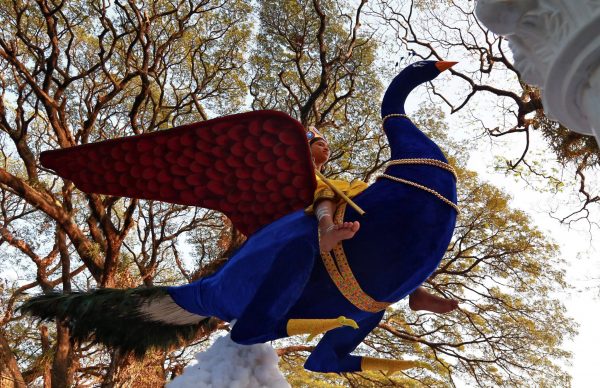Modi has certainly carved a new place for India on the global political stage. His energetic diplomacy has reinvented India’s place in the world: he has shaped new partnerships with Israel and Iran and has cemented them with Australia, Canada and Japan, reinventing non-alignment. The corridor to Africa has been a signature initiative in which Modi has been joined by Japan. India’s relations with its neighbours Bangladesh and Sri Lanka are on the up, though there’s still no breakthrough on Pakistan. The positive trajectory of US–India relations continued with Modi’s trip to Washington in late June. Despite their border dispute in Doklam, development of pragmatic cooperation has marked the important relationship with China.
Perhaps Modi’s diplomatic success has over-excited strategists in Tokyo, Washington and Canberra whose strong suit is not the arithmetic of economic power. Despite respectable economic growth under his administration, it will take decades to catch up to China given that China’s GDP is close to five times that of India’s. India’s growth has been weakening over the past five quarters and even with its boost last quarter to an annualised 6.3 per cent, the bald fact is that India’s share of global output continues to shrink against China’s.
More than patient play is needed to turn the game around. Modi has certainly racked up some economic wins at home: he has put in place reforms that build respect for the market economy, engineered tax reform, undertaken demonetisation reform and prised open the door to more vigorous foreign investor partnering in Indian economic development. But it has been a more laborious and less sure-footed process than it might have been. This is partly because the overarching strategic goal of invigorating development has been less visible than it needs to be.
India has never fully embraced the idea of an export-oriented development strategy because of the misconceived idea that its domestic market is ‘large enough’ — even when it is apparent that the global market is massive by comparison and interaction with it is critical to India’s international competitiveness, as Modi himself has argued persuasively. Domestic reform is yet to be linked decisively to international economic diplomatic strategy.
As Dhiraj Nayyar says, India needs to capture a much larger share of the global market than its present 1.6 per cent and it needs a greater share of foreign investment. If there is to be a permanent shift in growth trajectory, now is the moment when India will have to give up its traditionally defensive posture on trade. The opportunity has never been better — China’s wages are rising, global foreign direct investment is looking for a new production base and Beijing is reorienting its economic strategy from export- to consumption-led growth.
As Nayyar also points out, ‘before batting for openness abroad, emerging economies (like India and China) need to put their houses in order. For many emerging economies the backlash against free markets is likely to stem from domestic free market systems that crony capitalism has vitiated. It is not surprising that the leaders of both China and India have devoted a considerable amount of political capital to combatting corruption. Corruption and cronyism are complex and chronic but must be fought to retain the legitimacy of open market economies, which have delivered more prosperity than any alternative system in the last hundred years’.
In this week’s lead essay, Suman Bery reckons that there’s no consensus on why India’s growth has remained lacklustre. He nominates India’s ‘twin balance sheet’ problem as one reason: corporate borrowers cannot repay the banks on loans contracted in the boom years and the banks — whose majority owner is the government — lack capital to extend fresh credit. At a deeper level there is uncertainty about the relationship between private capital and the government. China is not the only major economy in Asia burdened by its state-owned banking problem. The opposition (unsurprisingly says Bery) blames the deceleration of growth on the burdens of demonetisation.
Understanding India’s growth challenge and what the Modi government now needs to do to deal with it means getting it into international perspective. India and China now both hold the key to a new global political economy.
Embracing openness is a hard choice even if the rest of the world is in good policy shape. When the United States and other advanced economies are threatening to close up economically it becomes that much harder. But failing to do so now will only slow growth more and condemn India, with its rapid population growth, to continuing stagnation.
The particular challenge for India and China, as the two fastest-growing major economies in the world, is to engage with each other and with other willing partner nations to maintain openness and embrace globalisation. As Nayyar points out, East Asia’s Regional Comprehensive Economic Partnership is a natural place where this engagement can happen.
After a steady stream of electoral successes that reinforce his political position at home, Modi is well-placed this year to seize India’s strategic moment.
The EAF Editorial Board is comprised of Peter Drysdale, Shiro Armstrong, Ben Ascione, Amy King, Liam Gammon, Jillian Mowbray-Tsutsumi and Ben Hillman, and is located in the Crawford School of Public Policy, College of Asia and the Pacific, The Australian National University.
This article is part of an EAF special feature series on 2017 in review and the year ahead.


What about investing in the educational system in the poor areas of India?